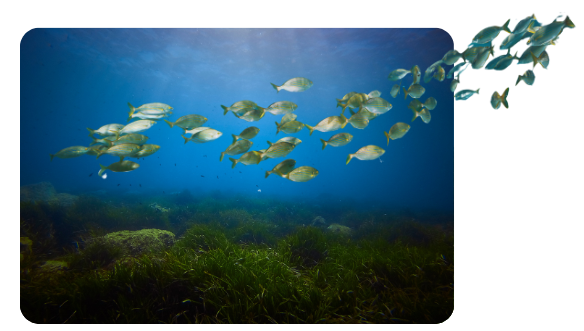Story
Measuring ocean colour
10 May 2021
Accurate satellite measurements of ocean colour are vital for assessing the health of the ocean. A new study, part of the AMT4OceanSatFlux programme, assesses a range of ocean colour products used for taking these measurements.

From ocean colour measurements, the concentration of chlorophyll can be estimated which is used as a proxy for phytoplankton biomass – the tiny marine plants that are the basis of the food web upon which all marine life depends.
There is much interest in long-term chlorophyll trends in the central unproductive regions of the oceans, the oligotrophic gyres, due to the possible expansion of these vast ocean deserts as the climate changes.
However, measuring chlorophyll directly in the ocean is very labour intensive, so the number of measurements are limited in time and space, with most sampling concentrating on the more easily accessible coastal regions.
For the past 20 years, satellites have been used to gain a much broader and frequent coverage of ocean colour, but we still need to ensure these measurements are accurate by comparing them with reliable in situ measurements from a range of water types.
There are several satellite ocean colour products available but very few studies have compared their performance, and these assessments have generally been limited to coastal and eutrophic waters.
The Atlantic Meridional Transect (AMT) is a programme undertaking research during an annual voyage between the UK and the South Atlantic, passing through a wide range of ecosystems, making it an ideal platform to collect in situ data for assessing the performance of ocean colour products.
Using a semi-automated underway system that determines chlorophyll concentrations at very high resolution from the optical properties of particles in seawater, one million data points were obtained during the course of three sampling campaigns (2016-2018) which resulted in over 800 match-ups with satellite observations.
The work assessed the performance of the standard ocean colour product from the Ocean Land Colour Instrument (OLCI) onboard the Copernicus Sentinel 3A (S3-A) satellite, as well as the accuracy of two other products: NASA MODIS-Aqua and VIIRS chlorophyll products.
As ocean colour accounts for less than 10% of the signal detected by the sensor, atmospheric correction models are applied to the data to remove interference from light scattered by the atmosphere, so the performance of different atmospheric correction models was assessed.
The accuracy of the NASA MODIS-Aqua and VIIRS chlorophyll products was also determined and the performance of the two OLCI instruments onboard the Sentinel 3-A and 3-B satellites during their tandem phase was compared.
It was found that for OLCI data, chlorophyll derived using the POLYMER atmospheric correction model performed best, whereas chlorophyll from OLCI using the standard correction gave an underestimate at low chlorophyll concentrations.
Chlorophyll from VIIRS gave an overestimate at high concentrations whereas the 2018 reprocessing of MODIS-Aqua data showed good general performance. Image analysis has also shown that OLCI POLYMER gave the highest chlorophyll concentrations, the largest number of valid pixels and highest percentage coverage due to how the model deals with cloud edges and quality flags.
Whilst the accuracy of chlorophyll from both OLCI sensors was found to be good during the tandem phase of the Sentinel satellites, data from S3-B was found to be slightly more accurate. It was recommended that the POLYMER atmospheric correction model be applied to S3-A and S3-B OLCI for estimation of low-medium chlorophyll in open ocean and oligotrophic Atlantic waters.
The oligotrophic gyres constitute the majority of surface water of the global ocean, yet are under-represented in global databases and this work represents a significant advance in data from these regions. The global ocean colour record now spans over 20 years and has provided insight into global trends in chlorophyll.
Lead author, PML oceanographer Dr Gavin Tilstone, said: “The recommendations from this study will ensure the continued accuracy of ocean colour products and the data will underpin the quality of the new generation of ESA ocean observing satellites, which will be the principal European marine Earth Observation platform for the next 20 years.”
Related information
Performance of Ocean Colour Chlorophyll a algorithms for Sentinel-3 OLCI, MODIS-Aqua and Suomi-VIIRS in open-ocean waters of the Atlantic is published now in Remote Sensing of Environment
Find the original version of this article on the AMT4OceanSatFlux site
